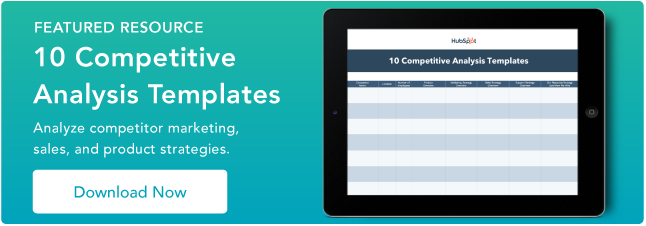An offering can't dominate a market as another "face in the crowd." The most successful products and services have some kind of edge — a defining, compelling x-factor that captures and capitalizes on potential customers' attention.
That "edge" is most commonly known as a competitive advantage — and if you want your business to survive and thrive, you need to identify and lean into yours.

Here, we'll further explore what a competitive advantage is, see how competitive advantage works, review some of the most common types of competitive advantage, and establish the steps you need to take to determine yours. Let's dive in.
What is competitive advantage?
A competitive advantage is a characteristic or factor a company possesses that allows it to bring more affordable, higher-quality, or more innovative products or services to market than its competitors.
Having a competitive advantage means being able to present your customer base with a unique, compelling reason to pick your product or service over your competitors. The market for virtually every product or service is flooded with a variety of options — all serving the same fundamental function.
Almost any airline can get you from point A to point B within a similar timeframe. Coke and some grocery store brand, generic cola are the same kind of soda. Apple and Samsung both make smartphones. And most of what's reported in the New York Times can probably be found in the Boston Globe.
And yet, shares within all of those markets are never evenly distributed. Certain products or services perform better than others — both in general and within specific niches. The offerings that take off (or even stay afloat) generally have something that sets them apart from similar products or services.
That "something" is a competitive advantage, and it typically comes in one of a few forms. Let's take a look at three of the most prominent types of competitive advantage — cost leadership, differentiation, and first mover.
Types of Competitive Advantage
Cost Leadership
Cost leadership might be the most prominent, straightforward type of competitive advantage. Simply put, it occurs when a firm can offer a product or service at a lower price than its competition without sacrificing too much quality.
Generally speaking, a cost leadership advantage is the byproduct of exceptional operational efficiency or low production costs. Companies often pursue this kind of advantage by taking strides like paying lower wages, auditing and streamlining production processes, or any other actions that can meaningfully chip away operating expenses.
Example of a Cost Leadership Competitive Advantage — Ryanair
European airline Ryanair sets itself apart from its competition via cost leadership. The company offers flight prices that consistently and significantly undercut what other airlines in the region are willing to charge.
Ryanair sustains its advantage through strategies like maintaining a large fleet of planes with limited aircraft variety — allowing them to purchase large quantities of spare parts — and cutting down on non-essential travel perks like free food and in-flight entertainment.
Differentiation
Where businesses pursuing a cost leadership competitive advantage focus primarily on price, companies looking to differentiate focus on quality — a differentiation advantage stems from delivering a product or service that's perceived as more innovative, luxurious, or better-constructed than similar offerings in its space.
Example of a Differentiation-Based Competitive Advantage — Emirates
Emirates, an airline based in Dubai, took a different road than Ryanair when it pursued its competitive advantage. Instead of skimping on in-flighty luxuries and non-essentials to help slash prices, Emirates indulged in them — and charged a sizable premium to compensate.
Economy flights on Emirates feature regionally inspired cuisine from flight destinations, in-flight digital entertainment with thousands of content options, onboard high-speed wifi, and several other perks meant to justify its hefty price tags. Those amenities help to set Emirates apart from other airlines and, in turn, give the company its competitive advantage.

First Mover
The first company to bring a new type of product, service, or technology to market often has the benefit of a first mover advantage. That kind of business has some extra room to establish a significant share of its market — after all, there's bound to be a stretch where a company with a first mover advantage is the only player in a brand new space.
These kinds of businesses can benefit from the credibility that comes with offering the "original" iteration of a product or service. But a lot of the time, a fast follower that emerges onto the scene with a competitive advantage of its own can overtake a first mover's market share — even when it starts from behind.
Example of a First Mover Competitive Advantage
eBay is a prominent example of a business that emerged with and mostly sustained a first mover competitive advantage. When it was founded in 1995, it was the first fully functional online auction site.
Backed by an exceptional, unique, well-executed concept, eBay was able to effectively create and dominate a new market — developing enough industry authority and brand recognition to maintain a significant competitive advantage over similar businesses in its space over time.
How to Identify Your Business’s Competitive Advantage
1. Thoroughly research your competition.
You can't understand what sets you apart from your market if you don't have a pulse on what that market looks like. Understand who your competitors are, what they're charging, who they're trying to appeal to, and how well they're performing. All of those factors — among others — are key components that will help you get a feel for your industry landscape and help you pin down where you'd like to be within it.
If you're selling sales automation software and notice that your competition is focusing primarily on large enterprises while alienating small businesses with their prices, you could consider trying to establish a cost leadership advantage to appeal to that segment of the market.
2. Review your prices and expenses, relative to your competition.
This point ties into the one above, but it bears mentioning on its own. You need to know your industry's pricing standards and what you can viably charge if you want to find the right competitive advantage. If lowering prices will radically undercut quality, slash your margins, and take a toll on your employees' wellbeing, pursuing a cost leadership advantage probably isn't your best bet.
3. Connect with your existing customers.
If you have loyal customers, find out why they chose and stuck with you and your offering. Conduct some outreach — whether that be through actions like conducting surveys or tapping your customer success team.
Having a feel for why real customers picked you over your competitors will give you a sincere, human perspective on your product or service's value. That kind of insight can be a major asset when determining your competitive advantage.
4. Lean into the advantage you identify.
Once you've found your competitive advantage, don't be reluctant to embrace it. Use it to guide how you structure and conduct your sales and marketing efforts. It might take some time for your strategy to stick — but when it does, you'll be in a more stable, effective position to separate yourself from the rest of your market.
As I said at the start of this article, your business can't survive and thrive without something that sets it apart from the rest of your market. That's why your competitive advantage might be the most important element to reference when shaping your sales and marketing strategies.
If you want to get the most out of virtually every facet of your business, you need to take the time to identify your competitive advantage and determine how to promote and leverage it as effectively as possible.
![Download Now: 10 Competitive Analysis Templates [Free Templates]](https://no-cache.hubspot.com/cta/default/53/b3ec18aa-f4b2-45e9-851f-6d359263e671.png)




![How to Create a Business Development Strategy for Your Sales Team [Template]](https://blog.hubspot.com/hubfs/business-development-strategy_0.webp)
